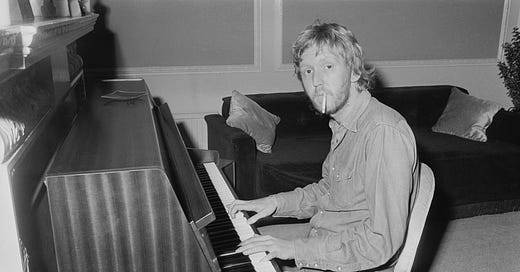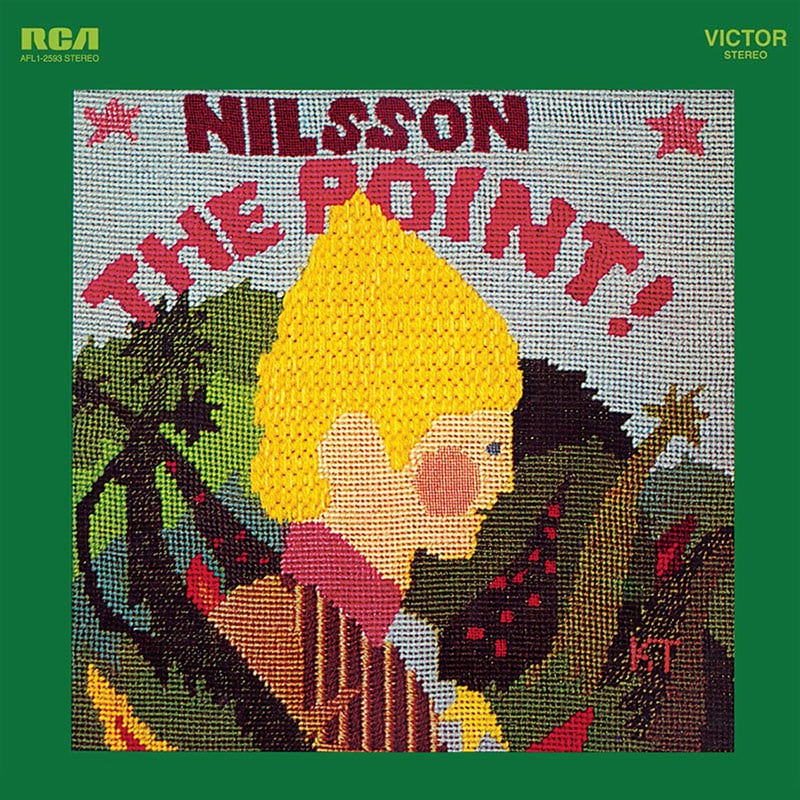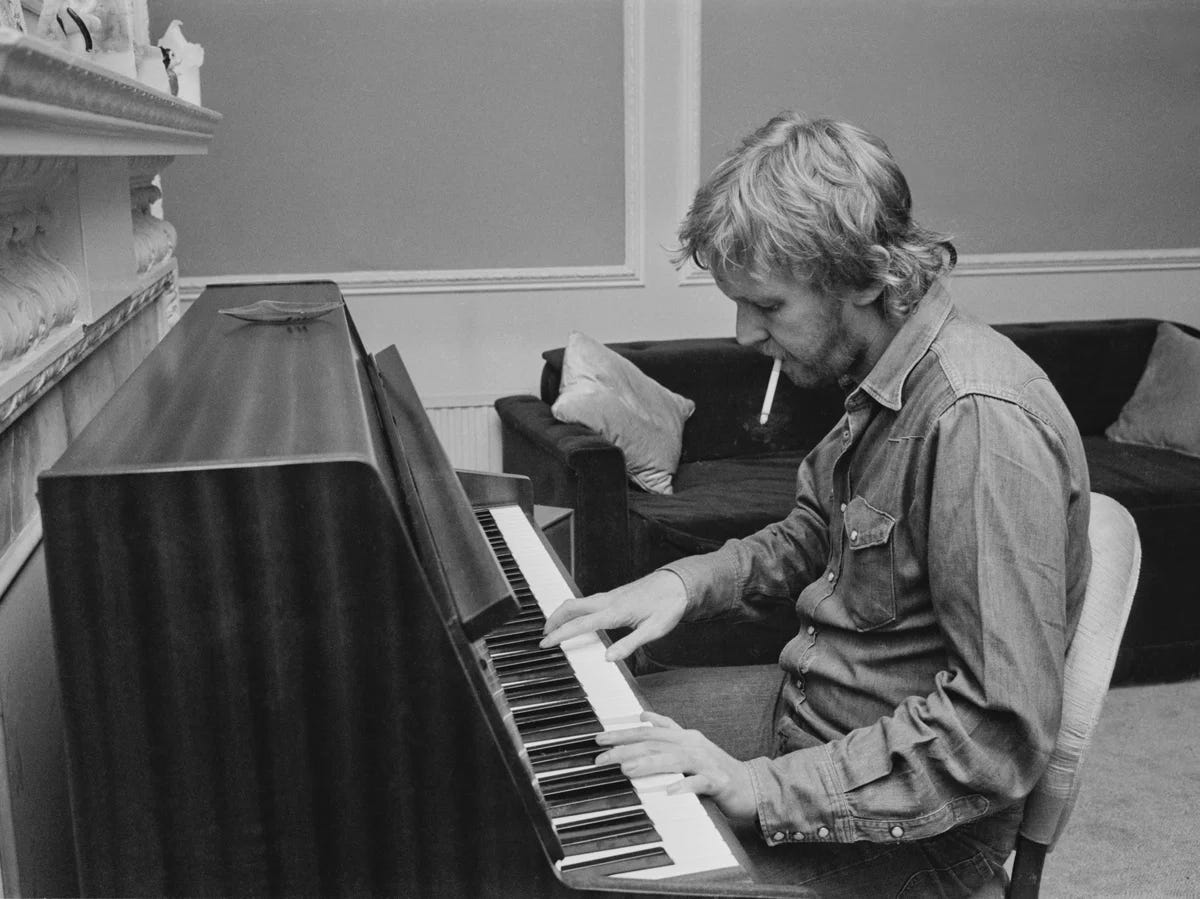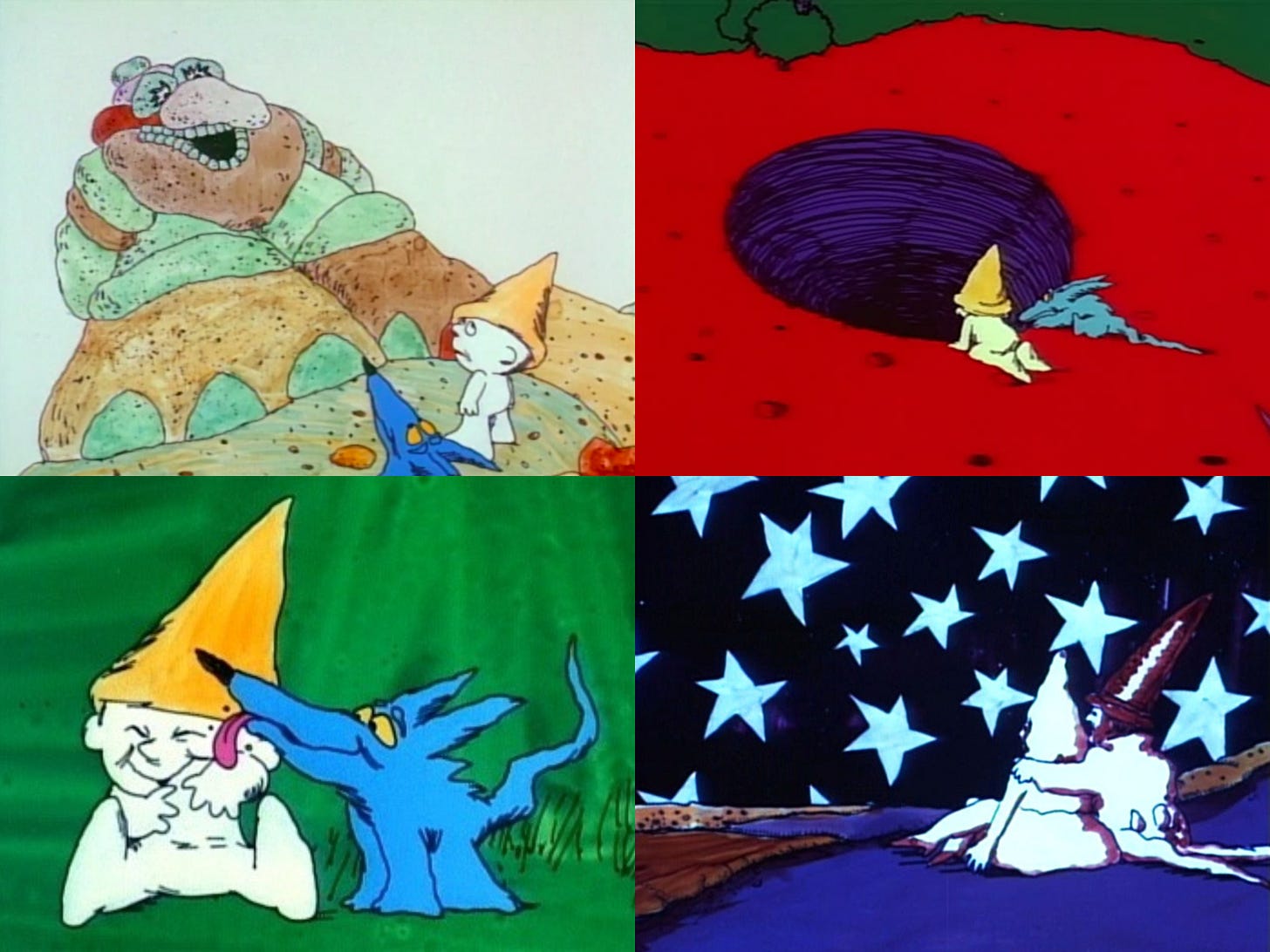I’m sure we’ve all basked in the pointlessness of it all. Going by our daily routines like insects, not standing still at the purpose of it all until we do, and we wait for it to hit us in our faces… and yet it doesn’t. Your alarm goes off, and you drag yourself out of your jumbled sheets and tiptoe down to the kitchen to make your cup of coffee, which you need to even be able to start your day. You don’t know your neighbour, so you don’t greet him on your walk to work after meticulously gathering your person-suit together, even though you don’t want to be perceived one way or another. You clock in to work at 9 and go home at 5; if you’re lucky, that kind colleague of yours drops you off at home, and you share small talk, which you hate but not if it’s with him. Then the mess of it all greets you—what’s the point?
I was weeks deep into my Dustin Hoffman obsession when I came across Harry Nilsson’s 1970 album The Point! Unaware of the two being connected, I pressed play one Tuesday morning and found myself surprised that it was a concept album revolving around a town where everything and every person had a point, except for a boy named Oblio, who was roundheaded—born without a point. It’s an ode to outsiders and outsider music told through a fable fit for children.
The album’s tracklist consists of 14 tracks in total, alternating between songs and narrations of the story. The opening track, Everything’s got ‘em, serves as an introduction to the town and its people Nilsson wishes us to meet. ‘This is the town where the people all have one (...). That’s the way they wanted it; that’s the way it’s going to stay.’ The percussion leads the track, intercepted by a handful of different instruments like piano, various flutes, horns and violin. Together with Nilsson’s signature harmonising, they provide us with an insight into what’s to come on following tracks.
Nilsson begins his first narration piece by telling us what life is like in the land of point, in particular for the main character Oblio. Being the only one born without a point on his head like everyone else in the land, Oblio stood out. And like any person who happens to stand out, Oblio fell victim to bullying and harassment by the other kids, resulting in his mother making a pointed cap for him to wear to fit in, at least, a little bit. Oblio had one friend, though, his dog, Arrow.
The following track Me and my Arrow is the theme song dedicated to Oblio and his trusty friend. ‘Me and my arrow, straighter than narrow. Wherever we go, everyone knows it's me and my arrow.’ A nostalgia-inducing track that takes me back to life as a ten-year-old, getting my first dog and going on countless walks and mini-adventures in our backyard. A playful song, and yet it lingers for a reason. As the album’s lead single, it peaked at number 34 on the Billboard Hot 100 at the time. It’s one of the greatest on the album, showcasing Nilsson’s love for harmonies and reminding me of why I love a band like The Lemon Twigs so much.
One day, Oblio wanted to participate in a game called triangle toss—the national pastime in the land of Point. You toss a triangle as far as you can, run to the opposite end of a field and catch it on the point of your head. Since Oblio didn’t have one, he would compete as a team with Arrow, who did the catching. Most pointy-headed kids thought this was fine until the son of the evil count insisted that only kids with points were allowed to compete. To settle the dispute, they held a contest: the best two out of three tosses and catches would win. If Oblio won, things would go on as usual; if the counts’ son won, Oblio wouldn’t be allowed to participate.
Which brings us to the track Poli High. What stands out most isn’t the narrative— there really isn’t a clear one—it’s the most soundtrack-like of all the songs. But the harmonies Nilsson utilises throughout the album stand out wonderfully in Poli High. My favourite part of the track is most definitely the bridge, which stands out against the rest; its vocal seems to be more on the front, in comparison to the harmonies which are plastered all over the backdrop of the music.
After Oblio’s win, the count heard the news, felt disgraced at the defeat of his son and called upon the king to hold a trial. The law states everything and every person must have a point, resulting in Oblio’s banishment to the pointless forest. Luckily for us, the distance between the Land of Point and the Pointless Forest is of equal measure to the amount of time it takes to sing a song.
The song in question? Think About Your Troubles, which might be the most philosophical track on the album. We hear sounds of water, as if the narrator of the song is descending into the ocean as the song opens with the lines, ‘Sit beside the breakfast table, think about your troubles. Pour yourself a cup of tea and think about the bubbles.’ There seem to be two rhythms taking place simultaneously throughout the song, with the first fading into the back as the other gets brought forward.
The body of water and the rhythms are a change of pace, both literally and figuratively; they provide a more melancholic sound as opposed to the upbeat one the album opens with, almost foreshadowing the dark turn the fable is about to take.
As the song progresses, so does the story. Pulling us from our seat at the breakfast table to the riverside, where we’re told to throw our tears into, which then get swept up by a tide into the ocean, where some fish, then even bigger fish and lastly a whale, get a bite of our tears before the mighty third verse takes over completely.
The third verse utilises some of the best songwriting on the album, opening with the words ‘He died and left his body to the bottom of the ocean’, moving on to decomposition and our body’s basic elements being given back to the ocean where the ‘sea does what it oughta’. Nilsson’s voice is at its most powerful in this track. You can almost feel yourself become one with nature.
At this point in the story, the two travellers reached their destination, the entrance of the Pointless Forest, where they meet the pointless man or the pointed man, depending on your point of view. The man did have a point—hundreds of them pointing in a million different directions—but as he pointed out to Oblio and Arrow, “A point in every direction is the same as no point at all!”
As they descend further into the Pointless Forest, our travellers begin to notice the trees and their branches and their leaves, but most importantly, that all of them had points! But before they could notice how strange this occurrence actually was, Arrow noticed a strange sound coming closer and closer… a not-so-well-meaning swarm of bees! Who followed the travellers deeper into the forest until they stumbled upon the most unusual rock pile, a new figure: the Rock Man.
Oblio asks the Rock Man if this place is in fact the Pointless Forest, to which the Rock Man replies, "Say, babe , isn't nuthin' pointless about this game. The thing is, you see what you wanna see, and you hear what you wanna hear. You dig? Did you ever see Paris?"
"No," says Oblio.
"Did you ever see New Delhi?"
"No," He says again. “Well, that's it. You see what you want to see, and you hear what you want to hear." The Rock man concludes and falls into his slumber as the travellers move along until suddenly, Arrow falls into a dark hole—the point of no return.
The sound of a harp takes us down to the bottom; we hear female vocalisation in the back as they harmonise with Nilsson’s melancholy lyrics. They call out to somebody in hopes of being heard—being saved—asking for a Life Line. The desperation seeps through as Nilsson begs for the listener to ‘please send down a lifeline.’ and the string arrangement during ‘I’m so afraid of darkness and down here it’s just like nighttime.’ makes this song another one of my favourites.
After their escape from the bottomless pit, Oblio and Arrow continued along the winding path, where they had a number of encounters with, amongst others, three sisters, the leaf man and a giant bird resembling a prehistoric pterodactyl, which swooped down and lifted the adventurers high above the pointless forest.
P.O.V. Waltz is as the title alludes, a waltz; but sillier. It makes you feel like you’re a feather floating over the strings you hear. This song feels like a high after the lows of the bottomless pit and Life Line. It takes you up there with the birds—waltzing with them through the clouds. The feelings the instrumentation evokes and the visualisation the lyrics provide go hand in hand like they’re partnered up during this dance.
After their sky waltz, the bird left Oblio and Arrow in its nest alongside an egg. As the egg began to crack, the strangest bird the travellers had ever encountered appeared. After a few moments of standing eye to eye with the bird, it flew away in pursuit of its parent, once more leaving Oblio and his friend feeling as lost as ever. Setting off again, they find a place to rest their weary heads beneath a tremendous boulder, falling into a deep sleep.
The final track Are You Sleeping? is another favourite of mine. The lyrics don’t seem to fit into the fable of Oblio but seem to be taking place while he dreams. In my ears, it’s the most meta of all tracks, almost like Nilsson is talking to us directly instead of telling a story. It feels like Oblio’s story and thus the album is drawing towards a conclusion—unknown whether the listener is going to return to his music in the future or end the short-lived friendship we entered when we pressed play. Nilsson forces us to think of an answer to his opening lines: ‘Are you sleeping? Can you hear me? Do you know if I am by your side?’ This song is a goodbye before Nilsson ends his story with one last narration piece. His very last words to us are ‘Thank you and good night.’
Meanwhile, in the story, Oblio wakes up bright and early the morning after, he notices the rock he was sleeping under was in the shape of a giant hand, pointing towards the way out of the Pointless Forest and back into the Land of the Point. When our travellers returned, they were greeted by a hero's welcome; the people were glad to see them, aside from one, as Oblio and Arrow were the first people from the land of the point to set foot into the Pointless Forest.
Our main character tells the people of the sights he’s seen and how he witnessed firsthand that the pointless forest wasn’t pointless at all. “In fact, the trees pointed… and the leaves on all the branches pointed…. In fact, even the branches pointed, and not only that, but everyone we met in the entire pointless forest had a point, and it's just that, well, it's just like here, and we figured since everything has a point, then I must have one too," he said. Before the count could voice his dismay, someone in the crowd spoke up, “He’s got a point there!” It turns out that even Oblio, when forced to take off his cap, had a point. There, on the top of his head!
An animated film adaptation of The Point! First aired on American television sets in February 1971 on the ABC-TV network. The fable of Oblio was directed by American animator Fred Wolf who based the film on the comic book illustrated by Gary Lund which was released alongside the vinyl record. In the film, Wolf utilised a framing device of a father telling his son said fable as a bedtime story. The voice of the father as well as the narration was done by Dustin Hoffman in its initial airing. Nilsson and Hoffman previously met and became friends, having both worked on the 1969 film Midnight Cowboy. Later on, since Hoffman only provided his voice for the broadcast, later airings have different narrators, as they had to be re-recorded.
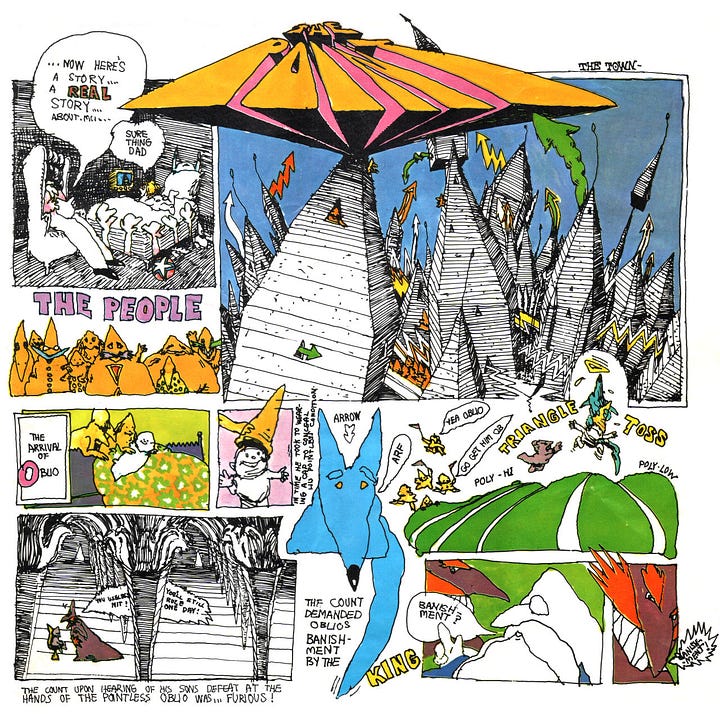
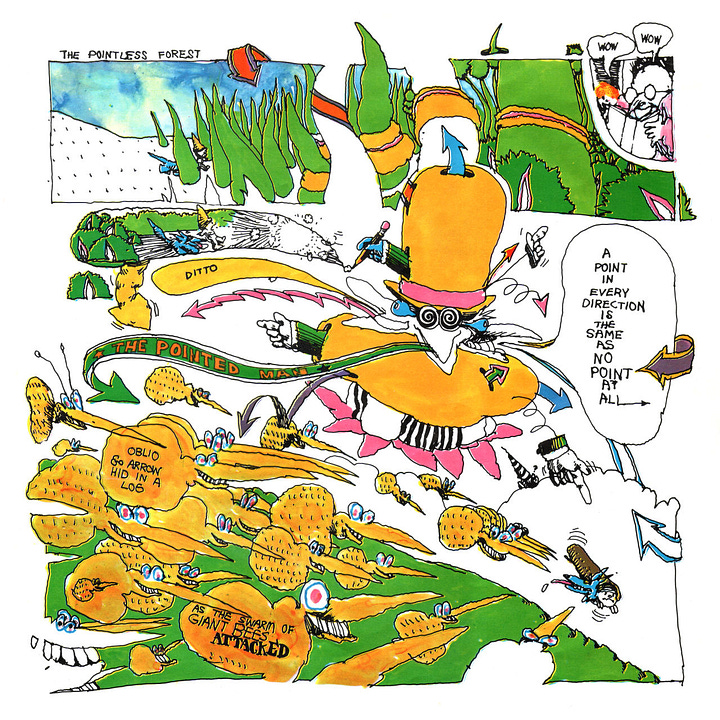
The film itself is obviously catered towards children but still provides plenty of pleasing visuals due to the surreal, water-coloresque animation. The song sequences especially make the 75 minutes fly by and are a great add-on to the album itself. What makes The Point! stand out from other animated films catered towards children at the time is the ‘adult commentary’ it provides by utilising its adult background characters. In the courtroom scene, for example, there’s a group of adults from the kingdom commenting on the treatment of Oblio without ever interacting with the main character himself. Kiefo Nilsson: ‘[...] the comments they make, it's like they're watching the movie with you in a way, and they kind of turn to you.’
What interested me even more was reading about the stage adaptation The Point! Received in the mid-70s. No video footage of the musical play survived, but a recording of the cast performing the album was released onto vinyl and remastered for CD in 2016.
It’s 1974, and Nilsson agrees to let the London-based Mermaid Theatre put on a stage production of his successful concept album for the Christmas season. Principal Dancer with the Royal Ballet, Wayne Sleep, was cast as Oblio together with a choreography to truly hone in on his talents. Critics loved this new adaptation, and the production got renewed for a second season—alas, Sleep was unable to commit in '77, and a new Oblio was needed.
A certain musical whiz kid by the name of Davy Jones took on the role—his fellow Monkee Micky Dolenz was then cast as the Son of the Count and the Leaf Man. Jones and Dolenz previously rose to fame in the TV show turned real band The Monkees and are, amongst other things, known for their comedic chemistry resulting in rewrites of their characters being done in order to take advantage of their chemistry.
The cast recording of the Jones/Dolenz production was only made available in 2016; no video footage of the show survived or was even made as far as we know. The new version of The Point! is something fresh for both fans of Nilsson and The Monkees, as it’s put into a completely different genre. Nilsson’s dreamy and mellow voice was replaced with a more uptempo and sometimes even disco feel. (Perfect for a man of Davy Jones’ stature).
The musical adaptation of The Point! is sure to satisfy the theatre kids among us. Jones and Dolenz are accompanied by both a female and male choir who take the lead on tracks like Poli High, and one can only imagine the grandeur of hearing the choir perform all the harmonies together.
I felt drawn in by the overture’s groovy bass and quirky flute and truly enjoyed my stay. But it remains hard to draw conclusions solely based on the audio recording, as it doesn’t include any dialogue or narration of the stage play. There are ad-libs here and there, like in Me and My Arrow, but what makes this adaptation of Nilsson’s masterpiece so enjoyable is how whimsical it is. Photographs show a marionette puppet of Arrow who was engineered by a puppeteer clad in all black. And seeing Micky Dolenz dressed in a costume that is pointy all over is very endearing to me.
Other songs from Nilsson’s catalogue were added to accommodate the expansion of The Point! to a full-length musical, and they are a welcoming surprise. Especially the two solos Dolenz performed jump out to me. Although Jones’ solos on this recording don’t pull me in as much as Nilsson’s original recordings or even Jones’ work with The Monkees—I expected more from Think About Your Troubles, as it feels like a quintessential Davy Jones song but was left feeling disappointed.
Luckily, Life Line proved to be the opposite. I could fully picture him on that stage, that famous vibrato of his reaching every single person in that audience, cooped together in a warm and safe room, tucked away from the cold December weather. It made me want to watch Head (1968) for a fourth time in anticipation of the scene where he performs Daddy’s Song, a song Nilsson happened to write.
If I had to pick a favourite adapted track, it would be the album’s closer, Are You Sleeping. Another song that feels like it goes hand in hand with Jones’ voice, with him taking the lead in the first half with the choir taking over on the second half. Although another Nilsson hit, Gotta Get Up, comes a close second for Jones’ lows and Dolenz’ highs coming together, time and again, to create something truly sublime.
Nilsson passed away in ‘94 but not before leaving his mark on the world. A tenor with a three-octave range, Nilsson’s legacy counts many hit singles and the title of pioneer when it comes to overdub sound mixing, as he was a multi-instrumentalist who mostly performed all vocal tracks himself. Although The Point! is sometimes overlooked compared to other works, it’s a testament to the power of combining great melody and lyrics. Nilsson’s son, Kiefo once said, “There's an interesting thing with the tonality because it's almost entirely major chords and a couple of dominant chords and only one minor chord. […] To the non-musicians: It's a little bit different to do things that way. Despite that, it still creates a lot of emotional depth because the melodies go to so many different places.”
Nilsson previously stated that the inspiration for The Point! came to him during an acid trip: “[...] I looked at the trees, and I realised that they all came to points, and the little branches came to points, and the houses [each] came to [a] point. I thought, 'Oh! Everything has a point, and if it doesn't, then there's [still] a point to it.”
Oblio’s journey is simultaneously a character-driven coming-of-age story as it is a hero’s journey, with Oblio being a voice for the marginalised. Born with a visible deformity, he’s the only person in the entire kingdom to stand out and to provide a voice for those who don’t have one.
Even when told through a child-friendly fable, Nilsson poses questions that awaken the deepest parts of our existentialist minds. What’s the point of anything we do? What’s the meaning of life, and is there one to begin with?
It sheds light on the systems in place to exert control over others by posing the same questions in the guise of obligation. Capitalist society only sees the validity of a person in correlation to their ‘point’, their purpose, and their contribution to said society. By putting a child in the centre of it, Nilsson reminds audiences that we are all put into this world with innocence, and it’s the people and the world around us that put us into a certain mould where we have to prove our worth when we didn’t ask to be born in the first place.
Ultimately, Nilsson makes us ask the most important question of all: why is there a need to measure a person’s worth? Why can’t we all just exist in spite of our colour or shape? Ultimately, the point of The Point! is quite clear, and it lies in the unity of outsiders—giving them a voice, protecting them and teaching others to embrace their differences. And importantly, lifting those outsiders into places of power in which they can thrive and usher in a free and just society.
On an individualistic level, the album serves as a reminder that it’s okay to just be. Merely existing is more than enough even on the days we feel like drowning in a sea of salty tears. On the one hand, it’s okay—encouraged even—to take a look at what’s inside of us. We are reminded to form a closer bond with ourselves, our loved ones and the natural world of all living things around us. But just as the rock man said, Nilsson and I wish to leave readers with one last reminder: “It never pays to submerge too deeply.”
Note from the author;
I would like to thank my friend Gee M. for proofreading this piece, I am eternally grateful to your kindness and feedback. My dearest Ra, for believing in my words and encouraging me on new ventures and all the gentle readers this newsletter has reached.

